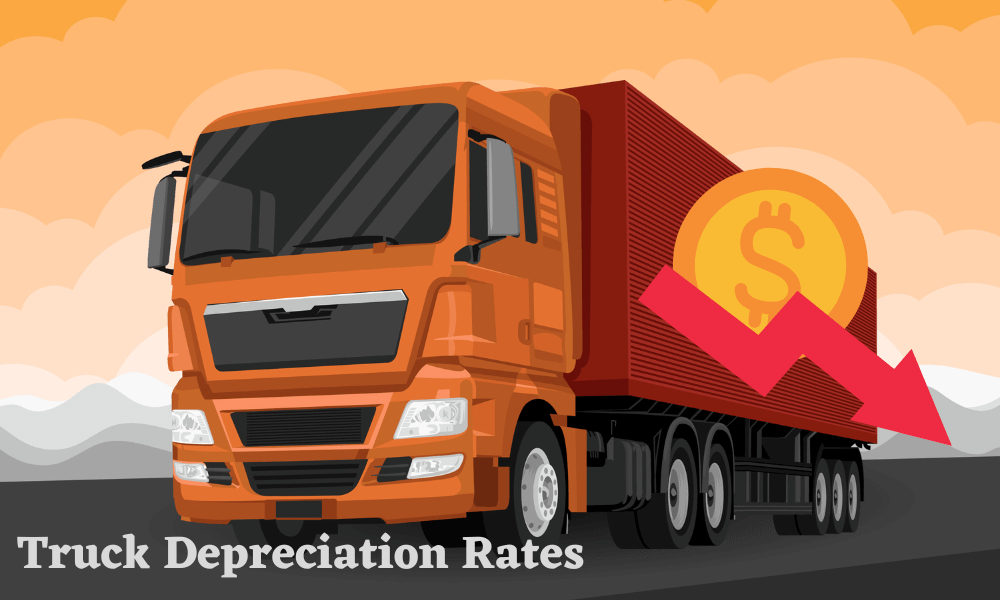
Are you Searching for a way to calculate Truck Depreciation Rate? Well, you’ve come to the right place! We will guide you through the process of calculating depreciation rates for your truck in a simple and easy-to-understand manner. In this blog, I will show you an example of a 32 feet multi-axle truck.
Table of Contents
What is the Depreciation Rate?
Before we dive into the calculation process, let’s first understand what depreciation is. Depreciation is the decrease in the value of an asset over time due to wear and tear, obsolescence, or any other factor that reduces its usefulness or value.
Why Calculate Depreciation Rate?
Calculating depreciation is important for several reasons. It helps in determining the actual value of the asset, which can be used for accounting and tax purposes. Depreciation also helps in deciding when to replace the asset and how much it can be sold for.
4 Main Methods of Depreciation Calculation
- Straight Line Method
- Declining Balance Method
- The sum of the Years Digits method(SYD)
- Modified Accelerated Cost Recovery System Method(MACRS)

Straight Line Method
With the Straight Line Method, you Select to depreciate your Truck at an Equal amount for each year over its useful lifespan.
Annual Depreciation =Depreciation factor * 1/Lifespan * Remaining book value
These steps help to calculate monthly straight-line depreciation:
Declining Balance Method
- Subtract the salvage asset value from its cost to determine the amount which can be depreciated
- Divide that amount by the number of years in the asset’s lifespan
- Divide by 12 by the monthly depreciation for the asset
This method is used to recognize the asset’s depreciation in the earlier lifespan
In, there are two variations of this method:
- Double Declining balance method
- 150% Declining Balance Method
To convert it from annual to monthly depreciation, so we can divide this result by 12
Annual depreciation = Depreciation factor *1/ Lifespan * Remaining Book value
The sum of the Years Digits method(SYD)
The method that takes an asset’s expected life and adds together the digits for each year is called the sum-of-the-years’-digits (SYD) method. It is an accelerated method to calculate depreciation values.
The Formula for calculating
Depreciation Expense = Remaining Useful Life of the Asset / Sum of the Year’s Digits * Depreciable Cost
Modified Accelerated Cost Recovery System Method(MACRS)
MACRS Method is generally used for tax purposes. It’s an accelerated depreciation method.
Calculating MACRS Depreciation is more complicated than the previous methods outlined above. You can use MACRS Depreciation Calculator, or get help from your tax advisor.
The Depreciation Calculation Process
The first step in calculating depreciation for your 32 feet multi-axle truck is to determine its useful life. The useful life is the estimated number of years that the truck will be useful before it becomes obsolete or needs to be replaced.
Next, you need to determine the salvage value of the truck. The salvage value is the estimated value of the truck at the end of its useful life. This value is used to determine the depreciation expense for the truck.
Once you have determined the useful life and salvage value of the truck, you can use the straight-line depreciation method to calculate the depreciation expense. The straight-line method is the easiest and most commonly used method for calculating depreciation.
Example:
The formula for calculating straight-line depreciation is:
Depreciation Expense = (Cost of Asset – Salvage Value) / Useful Life
Let’s break down the formula:
- Cost of Asset: This is the cost of the 32 feet multi-axle truck.
- Salvage Value: This is the estimated value of the truck at the end of its useful life.
- Useful Life: This is the estimated number of years that the truck will be useful.
For example, let’s say the cost of the 32 feet multi-axle truck is Rs 3500000, the salvage value is Rs 800000, and the useful life is 10 years. Using the formula above, we can calculate the depreciation expense for the truck as follows:
Depreciation Expense = (Rs 3500000 – Rs 800000) / 10 Depreciation Expense = Rs 270000 per year
Therefore, the annual depreciation expense for the 32 feet multi-axle truck is Rs 270000.
Let’s calculate the depreciation for a 32 feet multi-axle truck with the given values using different depreciation methods. Here’s a tabular column showcasing the calculations for each method:
| Year | Asset Value (in Rs) | Straight-line Depreciation (in Rs) | Declining Balance Depreciation (in Rs) | Sum-of-the-Years’ Digits Depreciation (in Rs) |
| 1 | 3,500,000 | 270,000 | 700,000 | 642,857 |
| 2 | 3,230,000 | 270,000 | 560,000 | 514,286 |
| 3 | 2,960,000 | 270,000 | 448,000 | 385,714 |
| 4 | 2,690,000 | 270,000 | 358,400 | 257,143 |
| 5 | 2,420,000 | 270,000 | 286,720 | 128,571 |
| 6 | 2,150,000 | 270,000 | 229,376 | 85,714 |
| 7 | 1,880,000 | 270,000 | 183,501 | 42,857 |
| 8 | 1,610,000 | 270,000 | 146,601 | 28,571 |
| 9 | 1,340,000 | 270,000 | 117,280 | 14,286 |
| 10 | 1,070,000 | 270,000 | 93,824 | 14,286 |
In the table above, the calculations are based on the given values: the cost of the truck is Rs 3,500,000, the salvage value is Rs 800,000, and the useful life is 10 years. Each depreciation method follows its respective calculation formula explained earlier. The Straight-Line Depreciation method assigns an equal depreciation expense of Rs 270,000 each year over the 10-year useful life.
Conclusion
Calculating depreciation rates for your 32 feet multi-axle truck is an important process that can help in determining the actual value of the truck. By using the above methods, you can easily calculate the depreciation expense for your truck. Remember to consider the factors that can affect depreciation and keep track of your truck’s value for accounting and tax purposes.
Jay
Jay is the Co-founder and CTO of FR8. With 18 years of experience, Jay loves working on complex problem and providing simple technical solution. He likes training and empowering team by teaching them skills they need, questions they need to ask and answers they need to figure out instead of spoon feeding the answers.






